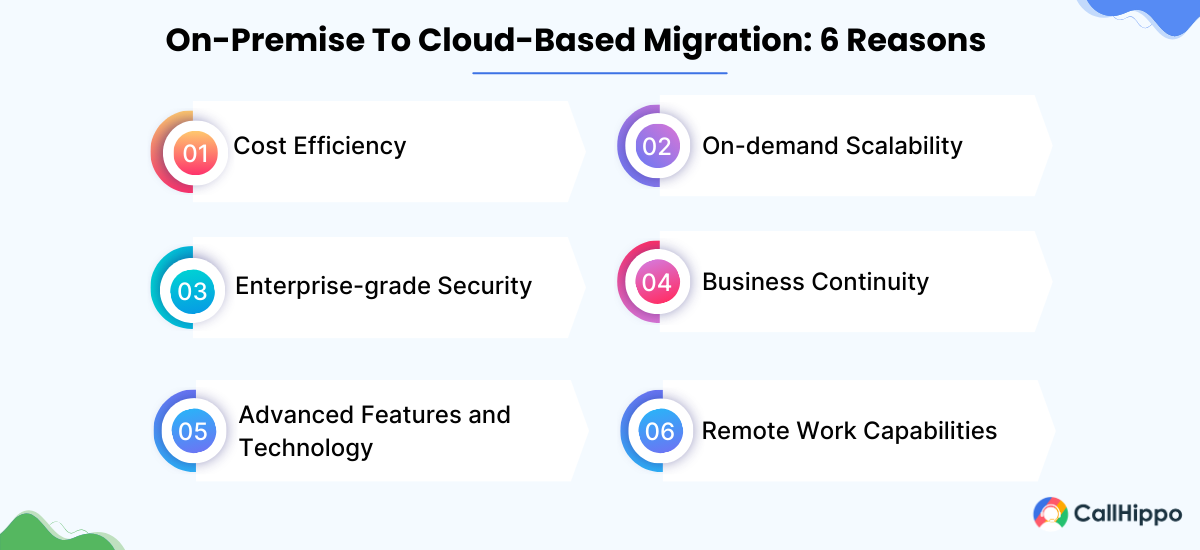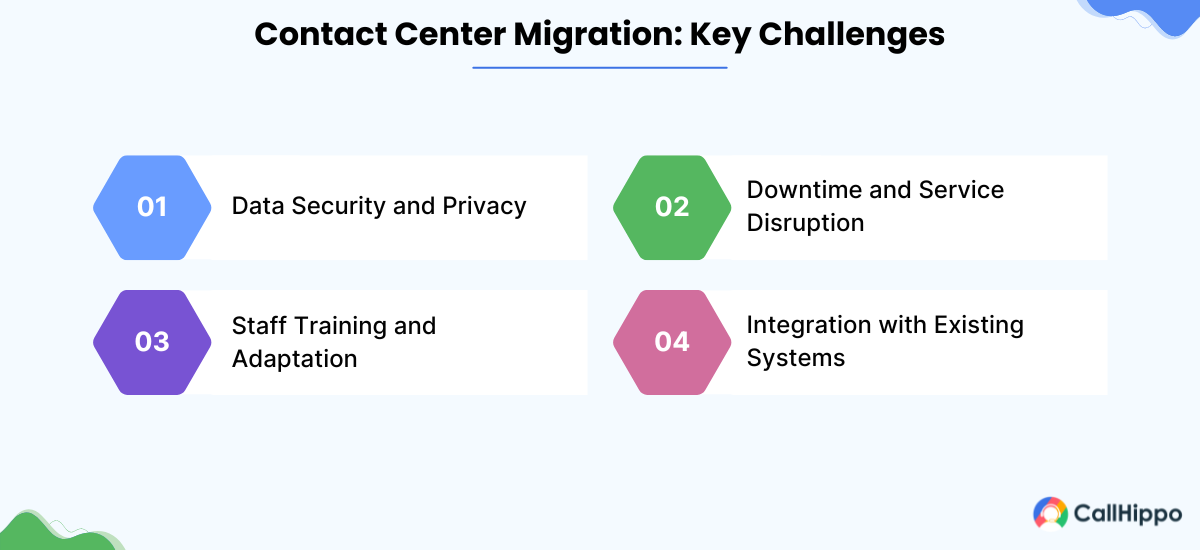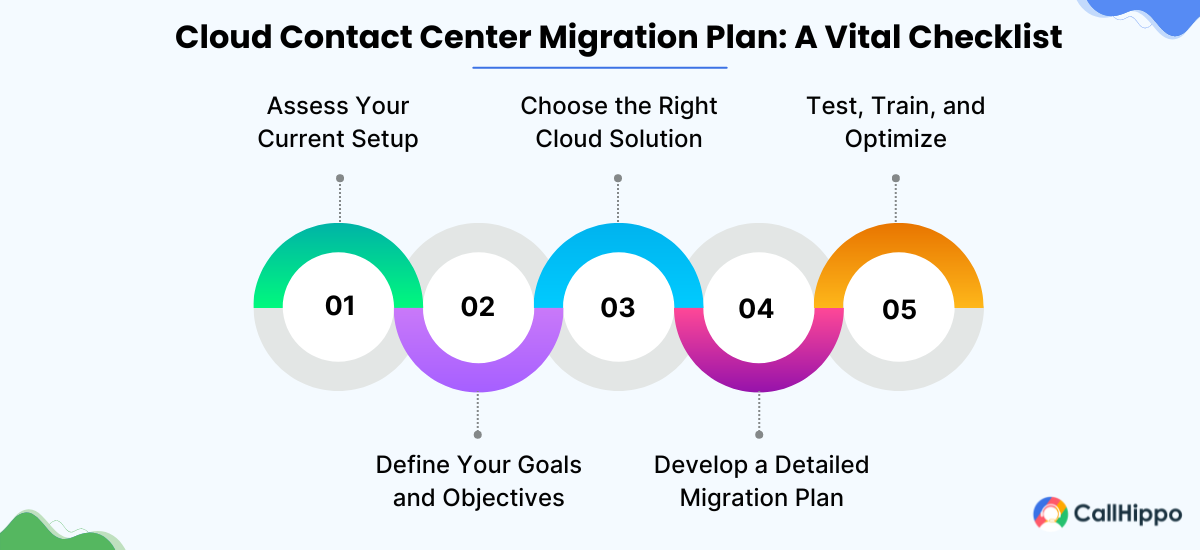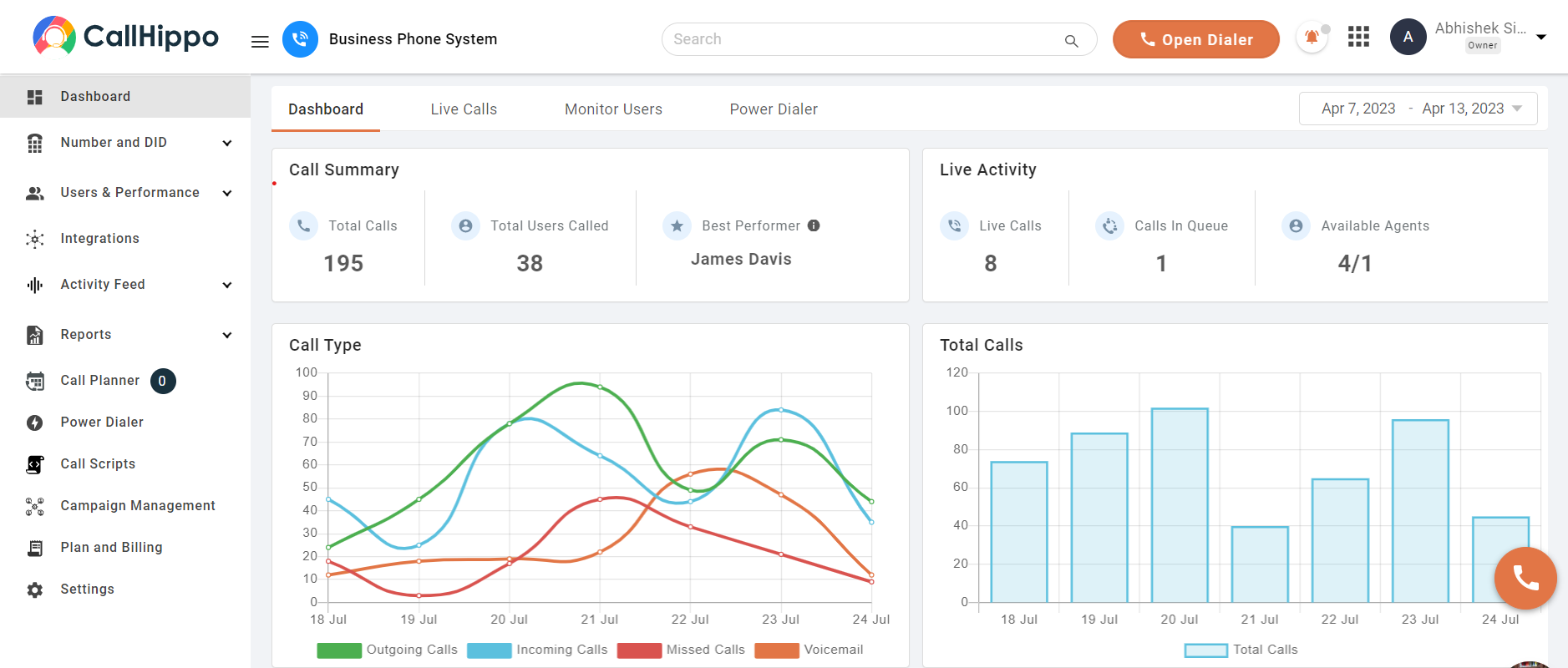More and more contact centers are migrating from on-premise to cloud-based architecture—clearly for valid reasons and to align with the evolving technology landscape. However, the journey of contact center migration is full of challenges.
In this blog, we will explore the reasons behind the shift from on-premise to cloud-based call centers or contact centers, the key challenges in contact center cloud migration, and provide a vital checklist for successfully migrating to a cloud contact center.
Let’s get started.
Before migrating your contact center to the cloud, conduct thorough testing in a controlled environment. This allows you to identify and resolve potential issues before going live. Engage with stakeholders, including agents and IT teams, to gather feedback and ensure a smooth transition for all involved parties.
Why Do Contact Centers Migrate from On-Premise to Cloud-Based Contact Centers?
With the continuous technological advancements, many businesses are moving from traditional on-premise setups to modern cloud-based contact centers. But why is this shift happening? Let’s look at the five reasons that that driving this change:

1. Cost Efficiency
One of the biggest reasons for contact center migration is cost savings. Switching to a cloud-based contact center can significantly reduce operational costs. With on-premise systems, businesses need to invest heavily in hardware, software, and maintenance. These expenses add up quickly.
On the other hand, cloud contact center migration allows companies to pay for what they use, often on a subscription basis. This shift eliminates the need for substantial upfront investments and ongoing maintenance costs.
2. On-demand Scalability
The next compelling reason for contact center cloud migration is the ease of scaling operations. As your business grows or experiences seasonal fluctuations, a cloud-based system can easily adjust to your needs.
You can quickly add or remove agents without the hassle of installing new hardware or software. This flexibility ensures that your contact center migration plan can adapt to changing demands efficiently.
On the other hand, this extent of flexibility is not at all possible in the case of an on-premise contact center. Rather, on-premise systems require significant time and resources to scale up or down.
3. Enterprise-grade Security and Compliance
The third reason behind this shift is security. Cloud service providers invest heavily in security measures to protect sensitive customer data. They often offer better security features than many on-premise systems can provide.
Moreover, these providers stay updated with the latest compliance standards, ensuring that your business adheres to regulations. This solid security architecture is a significant advantage of cloud contact center migration as it gives you peace of mind that your data is safe.
4. Business Continuity
Business continuity is another major reason behind shifting from on-premise to cloud-based contact centers. When you partner with a leading cloud contact center provider like CallHippo, you can be assured that your system will be up and running non-stop.
You cannot ensure this level of uptime with an on-premise contact center. Additionally, these providers offer better disaster recovery and quick data backup, reducing the risk of downtime during emergencies.
To sum up, business continuity is one of the major reasons behind contact center migration.
5. Advanced Features and Technology
Unlike on-premise contact centers, cloud-based contact centers come equipped with the latest technology and features, such as artificial intelligence (AI), machine learning, and advanced analytics. These tools can significantly improve the efficiency and effectiveness of your customer service operations.
For instance, AI can help route calls more intelligently, and analytics can provide insights into customer behavior. By incorporating these advanced features into your contact center migration plan, you can stay ahead of the competition.
6. Remote Work Capabilities
The last factor that contributes to this shift from on-premise to cloud contact centers is remote work. Cloud contact center migration supports remote work by allowing agents to access the system from anywhere with an internet connection.
This capability not only ensures business continuity during unforeseen disruptions but also opens up opportunities to hire talent from different geographic locations, improving the quality of customer service.
So these are the five factors contributing to the shift from on-premise contact centers to cloud contact centers.
Common Challenges of Contact Center Migration
Suppose you’ve decided to migrate your contact center from on-premise to the cloud. However, there are some challenges you need to be aware of. Let’s look at the three major challenges of contact center migration.

1. Data Security and Privacy
One of the biggest concerns during a contact center cloud migration is data security and privacy. When your data moves from local servers to the cloud, it becomes crucial to ensure that all sensitive information is adequately protected.
Make sure your cloud provider complies with industry standards and regulations such as GDPR or CCPA. Part of your contact center migration plan should include evaluating the security measures of potential cloud vendors and ensuring they have robust encryption and security protocols in place.
2. Downtime and Service Disruption
Another significant challenge during any contact center migration is the potential for downtime and service disruptions. Your customers expect continuous, uninterrupted service and even minor disruptions can lead to dissatisfaction and loss of business.
To minimize downtime, it’s vital to have a detailed contact center migration plan. This plan should include steps for a phased migration, allowing parts of your system to be moved incrementally rather than all at once.
Additionally, make sure you have a backup system in place to ensure that customer service remains active while the migration is underway.
3. Staff Training and Adaptation
Moving to a cloud contact center often involves new business tools and technologies that your staff may not be familiar with. This change can lead to a learning curve, potentially impacting productivity. To address this, include comprehensive training programs in your contact center cloud migration strategy.
Besides, ensure that your team understands how to use the new system and its features effectively. Also, consider running workshops, providing training materials, and offering ongoing support to help your staff adapt smoothly. All these exercises will help you in mitigating resistance to change.
4. Integration with Existing Systems
The last major challenge of contact center migration is integrating your new cloud contact center with your existing systems. Your contact center likely relies on various software for CRM, ticketing, and analytics, all of which need to work seamlessly with your new cloud-based solution.
During your contact center migration planning, ensure that the cloud provider offers compatibility with your current tools or provides APIs that facilitate integration. Consider testing these integrations thoroughly before going live to identify and resolve any issues early. This will eventually ensure a smoother transition.
A Cloud Contact Center Migration Plan Checklist
Now that you have a clear understanding of why businesses are migrating towards cloud contact centers from on-premise setups, as well as the challenges along the way, let’s now look at a vital checklist for a successful contact center migration.

1. Assess Your Current Setup
First things first, take stock of your current contact center setup. What hardware and software are you using? How are your agents currently handling calls, emails, and chats?
- Hardware and Software Inventory: Take stock of all the hardware (like phones, servers) and software (CRM systems, call center applications) currently in use.
- Workflow Analysis: Understand how your agents handle calls, emails, chats, and other interactions.
- Performance Evaluation: Assess the performance metrics of your current contact center, such as call handling times and customer satisfaction ratings.
This assessment will help you identify what needs to be migrated to the cloud and areas that could benefit from improvement or optimization.
2. Define Your Goals and Objectives
Next, clearly define your goals and objectives, such as why you are considering a cloud contact center migration. Is it to improve scalability, reduce costs, enrich customer experience, or all of the above?
- Business Objectives: Determine why you want to migrate—whether it’s to improve scalability, enrich customer service, reduce costs, or all of these.
- Technical Goals: Specify technical goals such as integrating new features like omnichannel support or enhancing data security.
- Timeline and Milestones: Set realistic timelines and milestones for achieving these goals throughout the migration process.
Having clear objectives will guide your decisions and ensure that the migration aligns with your overall business strategy.
3. Choose the Right Cloud Solution
Not all cloud solutions are created equal. Selecting the appropriate cloud contact center solution is critical for a successful migration:

- Feature Requirements: Identify the specific features and functionalities you need, such as CRM integration, analytics capabilities, or AI-driven automation.
- Scalability: Assess whether the solution can scale up or down according to your business needs and seasonal fluctuations.
- Security Measures: Ensure that the cloud provider adheres to industry-standard security protocols to protect sensitive customer data.
Evaluate different providers based on these criteria to find the best fit for your organization.
4. Develop a Detailed Migration Plan
Once you’ve chosen a cloud contact center solution, it’s time to create a detailed contact center migration plan. Break down the migration process into multiple phases.
- Phased Approach: Break down the migration process into phases, starting with a pilot phase, if possible, to test functionalities and identify potential issues.
- Roles and Responsibilities: Clearly define roles and responsibilities for each team member involved in the migration, including IT staff, contact center managers, and customer support agents.
- Risk Management: Identify potential risks and develop mitigation strategies to minimize disruptions during the migration process.
A detailed plan will help you stay organized and address challenges proactively throughout the migration journey.
Migrate to CallHippo Cloud Call Center
Switch to CallHippo for free! Enjoy 50+ purpose-designed features, a vast library of area codes, 99% system uptime, and more.
5. Test, Train, and Optimize
Before fully migrating your operations to the cloud, thorough testing is essential. Conduct comprehensive testing of all functionalities to identify any issues or gaps that need to be addressed.
- Testing Phase: Conduct rigorous testing of all functionalities and integrations to ensure they work seamlessly in the cloud environment.
- Agent Training: Provide comprehensive training to your agents on using new tools and workflows effectively to maintain productivity and deliver exceptional customer service.
- Performance Monitoring: Continuously monitor key performance metrics such as call resolution times, customer satisfaction scores, and agent productivity.
- Feedback Loop: Gather feedback from agents and customers to identify areas for further optimization and improvement.
By investing time and resources into testing, training, and optimization, you’ll ensure that your cloud-based contact center operates efficiently and meets your business objectives effectively.
Conclusion
As we can see, migrating contact centers from on-premise to the cloud is crucial at this time. However, for a successful transition, it’s essential to be aware of the challenges that may arise. Additionally, ensure you have a well-designed contact center migration plan before initiating the cloud migration process. If needed, consider hiring an expert with experience in this domain.
FAQ
1. What is meant by data center migration?
Data center migration refers to the process of transferring or relocating data, applications, and IT resources from one physical data center to another. The common reasons behind data migration are expansion, consolidation, or modernization.
2. What are the three main phases of cloud migration?
The three main phases of cloud migration are planning and assessment, migration itself, and post-migration monitoring and optimization. Planning ensures readiness, migration moves data, and optimization refines performance.
3. What are the seven R’s of cloud migration?
The seven R’s of cloud migration are Rehost (lift and shift), Replatform (lift, tinker, and shift), Repurchase (drop and shop), Refactor/re-architect, Retire, Retain, and Hybrid. Each R represents a different strategy for migrating applications to the cloud.
4. What is the most common cloud migration model?
The most common cloud migration model is the lift-and-shift approach, also known as rehosting. It involves moving applications and data from an on-premise environment to the cloud with minimal changes.

Subscribe to our newsletter & never miss our latest news and promotions.









